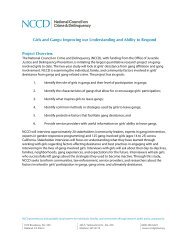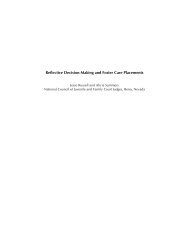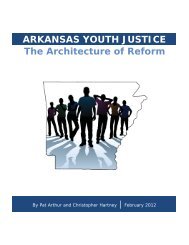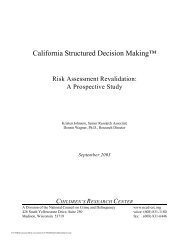Evaluation of the Insight Prison Project - National Council on Crime ...
Evaluation of the Insight Prison Project - National Council on Crime ...
Evaluation of the Insight Prison Project - National Council on Crime ...
Create successful ePaper yourself
Turn your PDF publications into a flip-book with our unique Google optimized e-Paper software.
References<br />
1<br />
Emoti<strong>on</strong>al Literacy, while still a comp<strong>on</strong>ent <str<strong>on</strong>g>of</str<strong>on</strong>g> IPP’s programming,<br />
is no l<strong>on</strong>ger part <str<strong>on</strong>g>of</str<strong>on</strong>g> <str<strong>on</strong>g>the</str<strong>on</strong>g> core course <str<strong>on</strong>g>of</str<strong>on</strong>g>ferings as a stand-al<strong>on</strong>e<br />
course. It is now an integrated practice in all IPP course <str<strong>on</strong>g>of</str<strong>on</strong>g>ferings.<br />
2<br />
Program descripti<strong>on</strong> provided by IPP staff.<br />
3<br />
Nugent, W., & Paddock, J. 1996. Evaluating <str<strong>on</strong>g>the</str<strong>on</strong>g> effects <str<strong>on</strong>g>of</str<strong>on</strong>g> a victim<str<strong>on</strong>g>of</str<strong>on</strong>g>fender<br />
rec<strong>on</strong>ciliati<strong>on</strong> program <strong>on</strong> re<str<strong>on</strong>g>of</str<strong>on</strong>g>fense. Research <strong>on</strong> Social<br />
Work Practice, 6, 2, 155–178; Roy, S. 1993. Victim meets <str<strong>on</strong>g>of</str<strong>on</strong>g>fender: A<br />
comparative study <strong>on</strong> juveniles and adults in a midwestern county.<br />
Journal <str<strong>on</strong>g>of</str<strong>on</strong>g> C<strong>on</strong>temporary Criminal Justice, 9, 2, 117–133; Hughes,<br />
S., & Schneider, A. 1989. Victim-<str<strong>on</strong>g>of</str<strong>on</strong>g>fender mediati<strong>on</strong>: A survey <str<strong>on</strong>g>of</str<strong>on</strong>g><br />
program characteristics and percepti<strong>on</strong>s <str<strong>on</strong>g>of</str<strong>on</strong>g> effectiveness. <strong>Crime</strong> and<br />
Delinquency, 35, 2, 217–233.<br />
4<br />
Duncombe, E. et al. 2005. Free inside: A program to help inmates<br />
cope with life in pris<strong>on</strong> at Maui Community Correcti<strong>on</strong>al Center.<br />
California Journal <str<strong>on</strong>g>of</str<strong>on</strong>g> Health Promoti<strong>on</strong>, 3, 4, 48–58; Telles S., & Naveen<br />
K. V. 1997. Yoga for rehabilitati<strong>on</strong>: An overview. Indian Journal <str<strong>on</strong>g>of</str<strong>on</strong>g><br />
Medical Sciences, 51, 123–7.<br />
5<br />
Brown, R. P., & Gerbarg, P. L. 2005. The Journal <str<strong>on</strong>g>of</str<strong>on</strong>g> Alternative and<br />
Complementary Medicine, 11, 1, 189–201; Pilkingt<strong>on</strong>, K., & Kirkwood,<br />
G. 2005. Yoga for depressi<strong>on</strong>: The research evidence. Journal<br />
<str<strong>on</strong>g>of</str<strong>on</strong>g> Affective Disorders, 89, 13–24; Johns<strong>on</strong>, S. J. 1974. Effects <str<strong>on</strong>g>of</str<strong>on</strong>g><br />
yoga-<str<strong>on</strong>g>the</str<strong>on</strong>g>rapy <strong>on</strong> c<strong>on</strong>flict resoluti<strong>on</strong>, self-c<strong>on</strong>cept, and emoti<strong>on</strong>al<br />
adjustment. Dissertati<strong>on</strong> Abstracts Internati<strong>on</strong>al, 34, 10-A, 6385.<br />
6<br />
<str<strong>on</strong>g>Insight</str<strong>on</strong>g> <str<strong>on</strong>g>Pris<strong>on</strong></str<strong>on</strong>g> <str<strong>on</strong>g>Project</str<strong>on</strong>g>. 2003. <str<strong>on</strong>g>Insight</str<strong>on</strong>g> <str<strong>on</strong>g>Pris<strong>on</strong></str<strong>on</strong>g> <str<strong>on</strong>g>Project</str<strong>on</strong>g> Programs. Web.<br />
March, 2011.<br />
7<br />
Gilligan, J., & Lee, B. 2001. Preventing violence. Prospects for<br />
Tomorrow series. Ed. Yorick Blumenfeld. New York: Thames & Huds<strong>on</strong>.<br />
127–8.<br />
13<br />
Rosenberg, M. 1965. Society and <str<strong>on</strong>g>the</str<strong>on</strong>g> adolescent self-image.<br />
Princet<strong>on</strong>, NJ: Princet<strong>on</strong> University Press.<br />
14<br />
Buss, A. H., & Perry, M. 1992. The aggressi<strong>on</strong> questi<strong>on</strong>naire.<br />
Journal <str<strong>on</strong>g>of</str<strong>on</strong>g> Pers<strong>on</strong>ality and Social Psychology, 63, 452–459; Bryant, F.<br />
B., & Smith, B. D. 2001. Refining <str<strong>on</strong>g>the</str<strong>on</strong>g> architecture <str<strong>on</strong>g>of</str<strong>on</strong>g> aggressi<strong>on</strong>: A<br />
measurement model for <str<strong>on</strong>g>the</str<strong>on</strong>g> Buss-Perry aggressi<strong>on</strong> questi<strong>on</strong>naire.<br />
Journal <str<strong>on</strong>g>of</str<strong>on</strong>g> Research in Pers<strong>on</strong>ality, 35, 138–167.<br />
15<br />
D’Zurilla, T. J., & Nezu, A. M. 1990. Development and preliminary<br />
evaluati<strong>on</strong> <str<strong>on</strong>g>of</str<strong>on</strong>g> <str<strong>on</strong>g>the</str<strong>on</strong>g> social problem-solving inventory (SPSI).<br />
Psychological Assessment: A Journal <str<strong>on</strong>g>of</str<strong>on</strong>g> C<strong>on</strong>sulting and Clinical<br />
Psychology, 2, 156–163.<br />
16<br />
Zimet, G. D., Powell, S. S., Farley, G. K., Werkman, S., & Berk<str<strong>on</strong>g>of</str<strong>on</strong>g>f, K.<br />
A. 1990. Psychometric characteristics <str<strong>on</strong>g>of</str<strong>on</strong>g> <str<strong>on</strong>g>the</str<strong>on</strong>g> multidimensi<strong>on</strong>al scale<br />
<str<strong>on</strong>g>of</str<strong>on</strong>g> perceived social support. Journal <str<strong>on</strong>g>of</str<strong>on</strong>g> Pers<strong>on</strong>ality Assessment, 55,<br />
610–17.<br />
17<br />
Beck, A. T. 1988. Beck Hopelessness Scale. The Psychological<br />
Corporati<strong>on</strong>. (NCCD adapted <str<strong>on</strong>g>the</str<strong>on</strong>g> published scale.)<br />
18<br />
H-Unit Findings. H-Unit analysis did not reveal a c<strong>on</strong>sistent<br />
difference between H-Unit participants with a six-m<strong>on</strong>th dosage<br />
and H-Unit participants with less than six m<strong>on</strong>ths. Prior discussi<strong>on</strong>s<br />
with IPP staff anticipated <str<strong>on</strong>g>the</str<strong>on</strong>g>se results (see Main Yard vs. H-Unit<br />
discussi<strong>on</strong> above). Classes with mostly H-Unit men require more<br />
time to process IPP materials and c<strong>on</strong>cepts because <str<strong>on</strong>g>the</str<strong>on</strong>g>y have<br />
not experienced life in custody to <str<strong>on</strong>g>the</str<strong>on</strong>g> extent Main Yard pris<strong>on</strong>ers<br />
have, and it takes time to build <str<strong>on</strong>g>the</str<strong>on</strong>g> trust and rapport necessary<br />
when participants are asked to share very pers<strong>on</strong>al issues. Indeed,<br />
H-Unit participants overall showed lower scores <strong>on</strong> <str<strong>on</strong>g>the</str<strong>on</strong>g> GES scale.<br />
Measuring <str<strong>on</strong>g>the</str<strong>on</strong>g> impact <str<strong>on</strong>g>of</str<strong>on</strong>g> IPP <strong>on</strong> H-Unit pris<strong>on</strong>ers would likely require<br />
a l<strong>on</strong>ger cut-<str<strong>on</strong>g>of</str<strong>on</strong>g>f point <str<strong>on</strong>g>of</str<strong>on</strong>g> at least a year and, as with <str<strong>on</strong>g>the</str<strong>on</strong>g> study <str<strong>on</strong>g>of</str<strong>on</strong>g> Main<br />
Yard pris<strong>on</strong>ers, a substantially larger sample size.<br />
8<br />
Levins<strong>on</strong>, R., Ingram, G., & Azcarate, E. 1968. “Aversive” group<br />
<str<strong>on</strong>g>the</str<strong>on</strong>g>rapy: Sometimes good medicine tastes bad. <strong>Crime</strong> and<br />
Delinquency, 14, 336–339; Rizzo, N. 1980. Group <str<strong>on</strong>g>the</str<strong>on</strong>g>rapy: Possibilities<br />
and pitfalls. Internati<strong>on</strong>al Journal <str<strong>on</strong>g>of</str<strong>on</strong>g> Offender Therapy and<br />
Comparative Criminology, 24, 27–31.<br />
9<br />
Morgan, R. D., Winterowd, C. L., & Ferrell, S. W. 1999. A nati<strong>on</strong>al<br />
survey <str<strong>on</strong>g>of</str<strong>on</strong>g> group psycho<str<strong>on</strong>g>the</str<strong>on</strong>g>rapy services in correcti<strong>on</strong>al facilities.<br />
Pr<str<strong>on</strong>g>of</str<strong>on</strong>g>essi<strong>on</strong>al Psychology: Research and Practice, 30, 6, 600–606.<br />
10<br />
Devilly, G. J., Sorbello, L., & Ward, T. 2005. <str<strong>on</strong>g>Pris<strong>on</strong></str<strong>on</strong>g>-based peereducati<strong>on</strong><br />
schemes. Aggressi<strong>on</strong> and Violent Behavior, 10, 219–240.<br />
11<br />
F<strong>on</strong>tana, L., & Beckerman, A. 1981. Training pris<strong>on</strong> inmates in social<br />
work. Internati<strong>on</strong>al Journal <str<strong>on</strong>g>of</str<strong>on</strong>g> Offender Therapy and Comparative<br />
Criminology, 25, 168.<br />
12<br />
Dosage is <str<strong>on</strong>g>the</str<strong>on</strong>g> combined total number <str<strong>on</strong>g>of</str<strong>on</strong>g> m<strong>on</strong>ths an inmate was<br />
enrolled in IPP courses (e.g., three m<strong>on</strong>ths <str<strong>on</strong>g>of</str<strong>on</strong>g> Emoti<strong>on</strong>al Literacy<br />
and seven m<strong>on</strong>ths <str<strong>on</strong>g>of</str<strong>on</strong>g> VOEG, taken at separate times or c<strong>on</strong>currently,<br />
would mean a combined total <str<strong>on</strong>g>of</str<strong>on</strong>g> 10 m<strong>on</strong>ths <str<strong>on</strong>g>of</str<strong>on</strong>g> IPP dosage).<br />
NCCD promotes just and equitable social systems for individuals, families, and communities through research, public policy, and practice.<br />
Page 11









